Cutting Edge Weaponry
It’s Wednesday today, and that means it’s time for another trip to the Magic Market, your one-stop-shop for magic items of every sort. It’s currently Sword Week, which means that I have a fine selection of quality magic blades for you to peruse. Feel free to look them over, but be careful not to touch: some of them are so sharp, and so deadly, that even the lightest touch of the blade might spell your doom.
Blade of Devotion
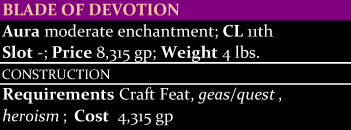
Each of these +1 longswords is made with a specific purpose in mind, and no two are quite alike. Their form is often a clue as to their origin, though it is not always readily apparent. A blade of devotion made to slay devils might have silver adornments on its pommel, and have an angelic motif, while one made to protect a king might bear symbols of royal authority.
Each blade of devotion has a specific purpose for which it was forged, and it is more potent while its wielder is acting in accordance with that purpose. These purposes are relatively specific, and usually involve slaying a specific individual, protecting a specific individual, conquering or defending a particular area (such as a town or valley, rather than a kingdom or continent), defending a specific treasure trove, etc.
Any time that it is wielded specifically in pursuit of its purpose, a blade of devotion’s enhancement bonus is treated as 2 higher than it actually is, and its wielder gains a +2 circumstance bonus to AC and to any saving throws he makes. The blade must actively be held in order to confer this bonus, and the wielder must be currently engaged in an activity directly related to the blade of devotion’s specific purpose. Once crafted, a blade of devotion’s purpose can never be changed, even with a wish or miracle spell.
When attempting to further enchant a blade of devotion, its special ability is equivalent to a +1 enhancement bonus, making it a +2 equivalent weapon.
Rogue’s Foil
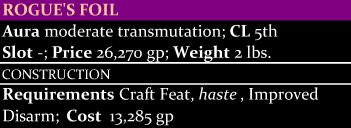
These +2 rapiers are favored by fencers, who consider them to be amongst the most elegant of weapons. They are also favored by any warrior who would rather disarm his opponent than harm him. Firstly, a rogue’s foil grants a +5 competence bonus to any Bluff checks its wielder makes to feint an opponent in combat. This bonus only applies while the rapier is held, and only to Bluff checks made to feint, not other Bluff checks.
Further, the wielder gains a +4 competence bonus to his CMB for any attempts made with the rogue’s foil to disarm his opponent. Additionally, if the disarm attempt is successful, the dropped item flies through the air, landing 2d4 squares in a random direction from the target. If you beat the target’s CMD by 10 or more, you may choose the exact square that it lands in, as long as that square is within 40 feet of the target.
Steel Dancer
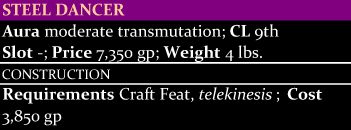
This +1 greatsword is exceptionally light. A pattern of whirls and designs are engraved into the blade, reminiscent of flowing breezes or furious zephyrs. They are largely disdained by dedicated swordsmen, but are highly prized by battle mages and warriors who tap into arcane power.
When held, a steel dancer is little more than a simple +1 greatsword. But, with a command word, the sword can be tossed into the air, at which point it animates, flying through the air at the control of its wielder. The wielder can, as a move action, move the sword up to 30 feet through the air (its maneuverability is considered clumsy). As a standard action, he can have the sword make a single attack at his full base attack bonus, and as a full-round action he can have the sword make attacks as though he had made a full attack action. In either case, instead of the wielder’s Strength modifier, the steel dancer uses the lesser of his Intelligence or Charisma modifier as a bonus to attack and damage for any attacks made while it is animated in this way (although attacks made with the sword while it is held use Strength, as normal).
If the wielder does not use any actions in a round to direct the steel dancer, it does nothing, merely hanging in the air. If three rounds pass in this way without the wielder directing the steel dancer, it falls to the ground, and must be retrieved before it can be controlled in this way again.
While being telepathically controlled, the steel dancer has an AC equal to 12 + its enhancement bonus + the higher of its wielder’s Intelligence or Charisma modifiers. Its hardness and hit points are unchanged. The steel dancer cannot be telepathically controlled while it has the broken condition.
Trickster’s Blade
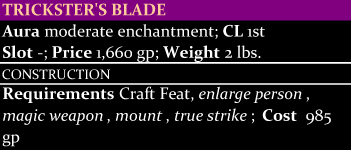
This masterwork short sword does not have an enhancement bonus, but can be used by clever fighters to gain a great advantage in combat. Three times per day, the blade can be used to cast any of the following spells as a spell-like ability: enlarge person (on the wielder only), magic weapon (on the trickster’s blade only), mount, or true strike.
A trickster’s blade can be enchanted with an enhancement bonus and magic weapon special abilities as though it were a normal, unenchanted blade.
Witch’s Bane
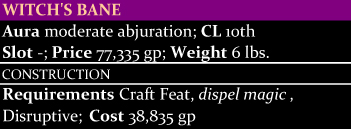
This +1 bastard sword glows with runes of power that have been carved down the length of its blade, and which emit an eerie, green light whenever the sword is within 30 feet of any creature that can cast arcane spells. The blade itself is made of a dull, lusterless black metal, and the hilt is made of gold, and carved in the shape of two intertwined serpents, their heads forming the crossguard, and with small rubies for their eyes.
The first witch’s bane was made by Jargan Voor, the Sorcerer King of Voormount. The last in a long line of sorcerer kings, the magic had run thin in Jargan, and he feared that a more powerful mage would rise up in his domain and challenge him for power. From this fear for his throne, he crafted a dozen or so of these blades, and appointed a number of knights as witch-hunters, outlawing the practice of magic within his realm by any but himself and those to whom he directly granted permission. These witch-hunters loyally slaughtered those who continued to practice magic within Voormount, until eventually one of them decided that Jargan Voor himself was no better than the witches they had slain, and the Sorcerer King was brought low by the very agents intended to protect his throne.
In addition to its enhancement bonus, and its warning glow when in proximity to an arcane spellcaster, the blade has a number of other magical properties. Firstly, when wielded against a creature capable of casting arcane spells, its enhancement bonus is treated as 2 higher and it deals an additional 2d6 damage with each successful hit. Secondly, whenever it successfully hits a creature, the blade tears through any magical enhancements or protections that might be on that creature. This functions as the targeted version of the spell dispel magic, except that it only dispels beneficial effects, and only those that are arcane in origin. Finally, the blade emits an aura that interferes with arcane spellcasting: creatures within 5 feet of a witch’s bane cannot cast spells defensively (though they can still cast them in the normal method, provoking an attack of opportunity).
When attempting to further enchant a witch’s bane sword, these additional abilities, taken together, are equivalent to a +3 enhancement bonus, making it a +4 equivalent weapon.


